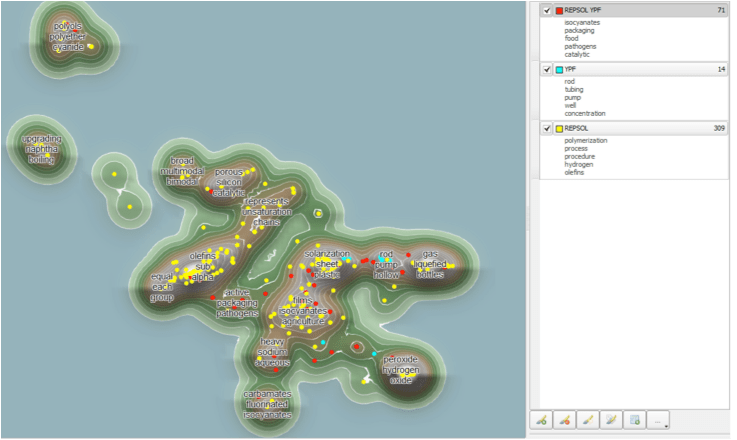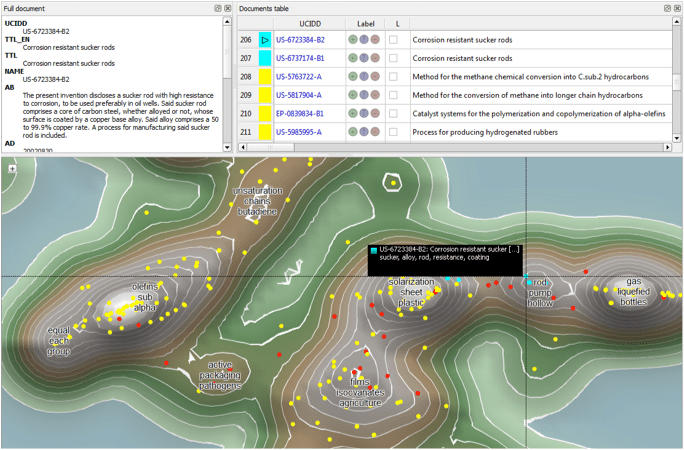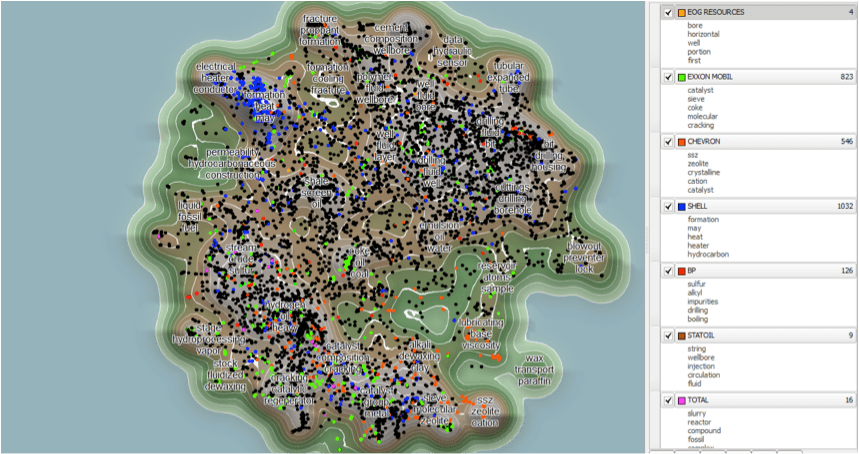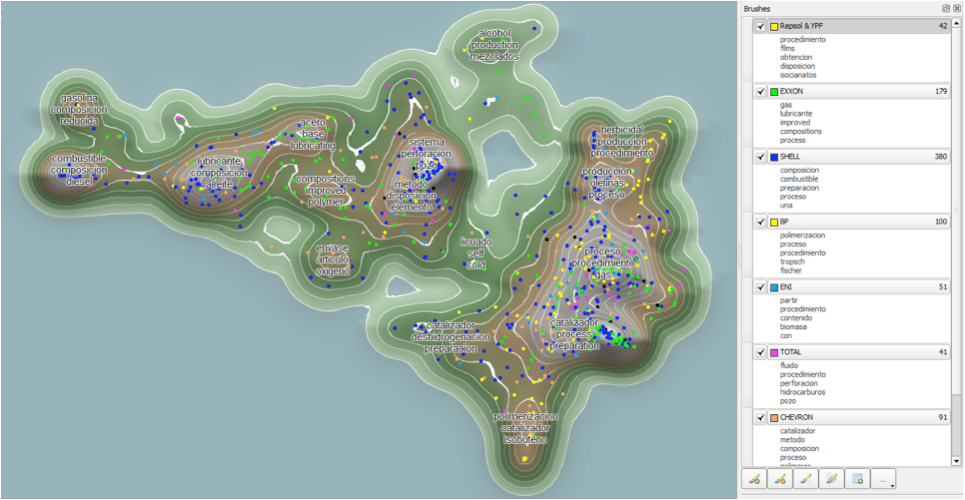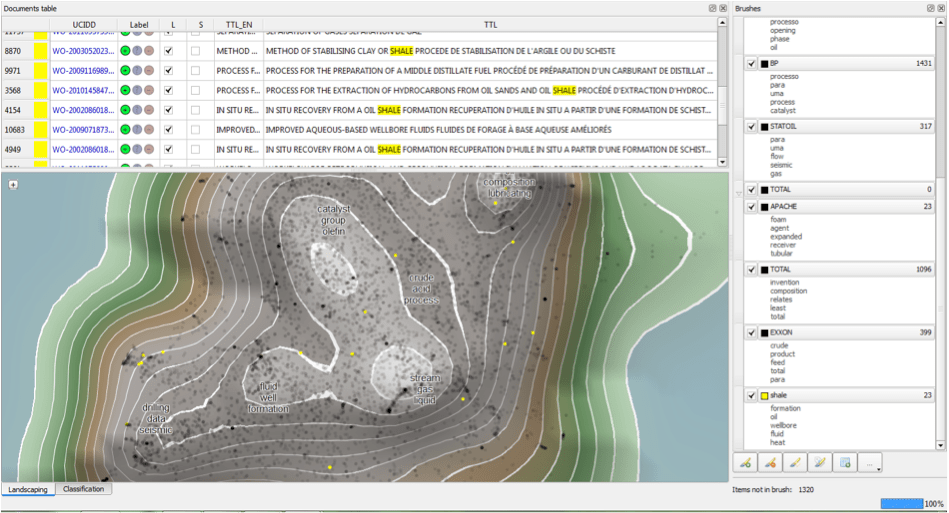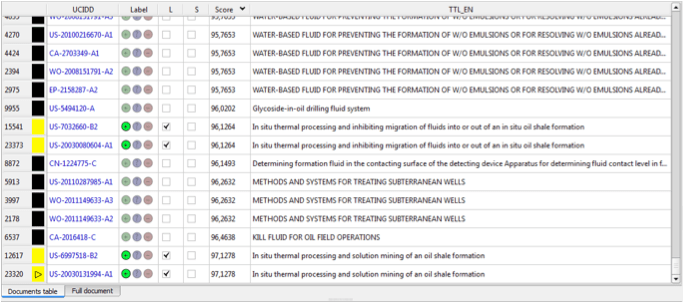In April this year, Argentina’s president, Cristina Fernández, announced her decision to seize control over Yacimientos Petroliferos Fiscales (YPF), the former Argentine oil firm that since 1999 had been part of the Spanish oil company, REPSOL, under the joint name of REPSOL YPF.
In this post we use the IFI CLAIMS Claims Direct patent database and KMX software to analyze the patent portfolio of these two major oil companies and offer some insights on the their current competitive situation after the expropriation.
By 1999 (year of the acquisition of YPF by REPSOL) YPF had only a few patents registered in Argentina and in the UK, whereas REPSOL had already filed nearly three hundred patent documents in several countries worldwide. Since 1999 onwards the patent portfolio of REPSOL and REPSOL YPF have increased, both in number of patents and in scope. Figure 1 shows the current landscape of enforced patents and patent applications by REPSOL YPF and REPSOL.
Figure 1
Figure 1. Landscape of REPSOL and YPF patent portfolio, generated through KMX
Patents coloured in cyan are those registered solely by Argentine YPF; the yellow ones are registered by Repsol and their divisions in Spain (Repsol Quimica SA, Repsol Butano SA); finally the red ones are the patents registered under the applicant joint name of RESOL YPF.
REPSOL is well known for its technologies related to the exploration and evaluation of subterranean formations of new crude resources and for the development of new catalysts for optimizing processes. REPSOL and YPF have jointly protected technologies related to several key oil production and packaging processes.
Figure 2
Figure 2. Here we zoom into the patent clusters and analyze a specific US granted patent from YPF (you can click any dot on the map to display the IFI CLAIMS fulltext details of the related patent document)
During the last year, some important discoveries of shale oil resources have been made in Argentina. Shale oil is a kind of oil produced by processes that are different from the conventional ones and which allow the conversion of organic matter within the rock into synthetic oil and gas that can be used immediately as a fuel or upgraded to meet refinery feedstock. In the present era, in which cheap abundant oil resources are becoming scarce, unconventional technologies such as shale oil represent a real alternative for energy production.
Major oil companies already investing in shale fields are the French oil giant Total and American companies such as Exxon Mobil amongst others. Figure 3 shows a landscape of the technologies related to Shale oil patented by major oil companies in the world.
Figure 3
Figure 3. Patent landscape of leading oil firms and their patented technologies related to shale oil
When having a look at the situation in Argentina we realize that unconventional oil technologies are so far hardly protected in this territory. Figure 4 shows a map generated through KMX of the technologies that are currently protected in Argentina by worldwide leading oil companies.
Figure 4
Figure 4. Landscape of technologies currently protected in Argentina by worldwide leading oil firms
With the loss of YPF, Repsol is sharpening its focus on other countries, namely Brazil as well as pursuing projects in the United States and Russia.
We can generate now a landscape showing the coverage of patents in Brazil by the top global oil companies (figure 5). KMX software allows you, for example, to easily identify those patents related specifically to shale oil and its synonyms (equivalent terms such as unconventional, in-situ retorting, kerogen, etc.) , and label them as interesting for your analysis. You can simply do this by clicking the green light positive icon over some of the patents in your set.
Figure 5
Figure 5. Labeling patents in KMX
Then you can prompt the KMX classifier to train the whole patent set. KMX will immediately group together all patents related to shale oil. The selected patent set can then be exported, listed and further studied separately.
Figure 6
Figure 6. Scoring patents related to Shale oil through the KMX Classifier
New landscapes can be generated. KMX classifications can also be saved and conveniently reused for other analysis. For example, one could consider studying the patents related to shale oil in another territory, for example, the USA.
KMX has a wide range of possible applications. If you have any questions, comments or would like information on KMX or IFI Claims patent databases, please contact us at info@ificlaims.com. For information on intellectual property in Spain and Latin America, or for questions about Iale Technología and our industry and technology reports, please contact me at enric@iale.es.
